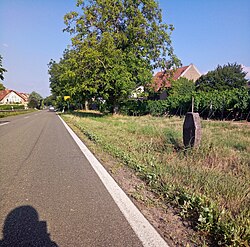Dirmsteiner cenotaphs
| Dirmsteiner cenotaphs | |
|---|---|
 Gerlitschke memorial stone, overview photo |
|
| Data | |
| place | Dirmstein |
| Client | L. Guth I., Johannes Probeck VI., Casinogesellschaft Dirmstein |
| Architectural style | Cast stone |
| Construction year | 1870 |
The Dirmsteiner cenotaphs are two memorial stones that remind of dead soldiers in 1870 and give the impression of graves. You are at the western exit of the municipality Dirmstein in the Bad Dürkheim district ( Rhineland-Palatinate ).
The memorial stones
These are two similar thin concrete blocks in an elongated octagon shape. You are at the western end of the town on the roadside, south of the L 453 (Obersülzer Straße), one about 100 m before and the other about 100 m after the Dirmstein sign.
The stone standing outside the village bears the inscription:
“ HERE DIED HEINRICH GERLITSCKE VOM K. PREUSS ON JULY 31, 1870. GG REGT. 3. COMP. QUEEN ELISABETH "
The stone in the local area is a bit smaller because it apparently broke off once below. The label reads:
“ HERE DIED GOTTFRIED NOWARE VOM K. PREUSS ON JULY 31, 1870. GG REGT. 1. COMP. QUEEN ELISABETH "
history
During the deployment as a result of the Franco-Prussian War of 1870/71 , the Queen Elisabeth Guard Grenadier Regiment No. 3 was transported in a 65-hour train ride from Breslau to Mannheim , where it arrived on the night of July 31, 1870. From there it should go west on foot. The milestones for July 31st were Obersülzen and Grünstadt ; the way led via Ludwigshafen am Rhein and Frankenthal .
The weather was oppressively hot and sunny, the soldiers quickly reached the limits of their strength during the fast march. Many even walked barefoot, as their feet had swollen from the long train journey and no longer fit into their boots. Residents of Dirmstein refreshed the soldiers with water as they marched past. According to local tradition, the regimental commander Konrad von Zaluskowski refused an urgently required rest. According to the official report, several soldiers suddenly collapsed on the slope of the road at the exit of Dirmstein, which leads in the direction of Obersülzen and is called Schießhohl on site , and had to be laid in the ditches where paramedics and doctors took care of them. Three grenadiers from the 1st Battalion died of heat stroke . They were Gottfried Noware from Minken in the district of Ohlau , Heinrich Gerlitschke from Zirlau in the district of Freiburg / Silesia and Ludwig Jahns from Pleschen . Another soldier named Michel died later that day. 18 men had to be admitted to the hospital sick, 76 people were unable to march for one or two days.
The grenadiers Noware, Gerlitschke and Jahns were buried in the cemetery in Obersülzen. The historical grave monument donated by the comrades has not been preserved. In its place today there is a modern commemorative plaque, which, however, has spelling mistakes in the names.
Two Dirmstein citizens - the locksmith L. Guth I. and the carpenter Johannes Probeck VI. - as well as the casino company Dirmstein donated the memorial stones that still exist today at the place of death of grenadiers Noware and Gerlitschke.
literature
- Constantin von Altrock : History of the Queen Elisabeth Guard Grenadier Regiment No. 3. , Berlin, 1897, p. 140 u. 141; (Digital scan).
- Joachim Specht: You only see heaven and Prussia - Grünstadt and its region in the Franco-German war . In: Heimatjahrbuch Landkreis Bad Dürkheim , Volume 22, 2004, pp. 240–243, ISBN 3-926775-35-1 .


